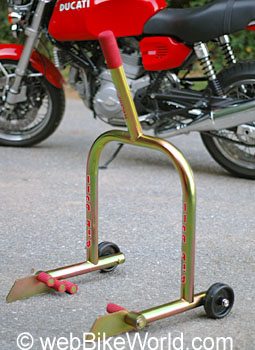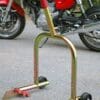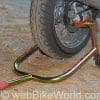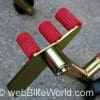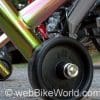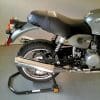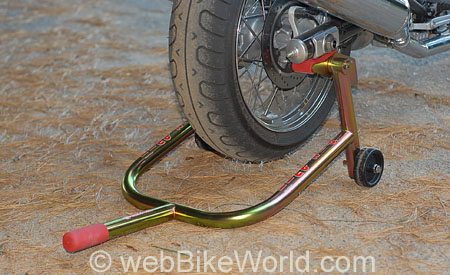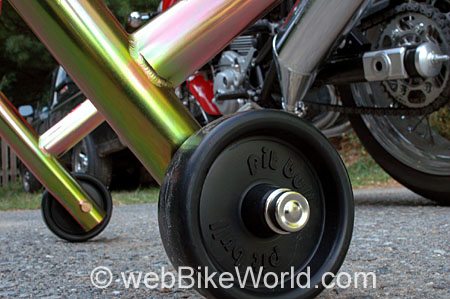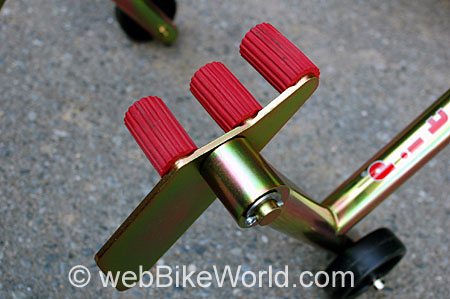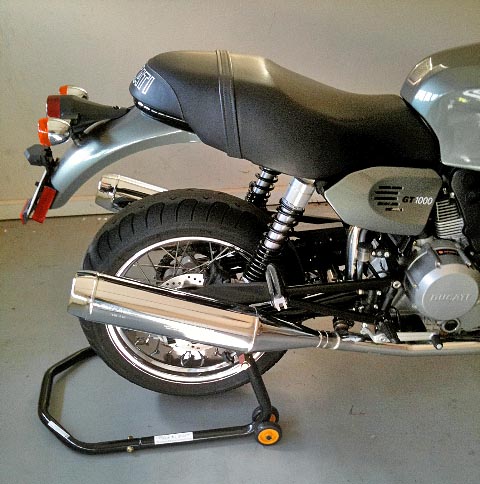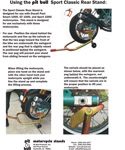The Pit Bull rear swingarm stand is a very sturdy and handy device.
It’s available in several different configurations, like the special design for the Ducati GT1000 and Sport Classic motorcycles that is the subject of this review.
NOTE: See updated instructions (below)
Until recently, every motorcycle I’ve owned has been fitted with an original equipment center stand, so it still comes as a shock that this essential device is missing from the vast majority of motorbikes.
I realize that the Sportbike crowd looks at center stands with the same disdain they hold for, say, 21″ front tires.
But ask anyone who owns a bike equipped with a center stand and I’m sure they’ll be singing its praises.
Owning a motorcycle means that at some point, the bike will simply have to be lifted vertically by its rear wheel, for anything from an oil change to a chain adjustment to fixing a flat.
So what’s really puzzling is that I don’t see or hear of very many motorcycle swingarm stands being discussed, purchased, used by all of those side-stand-only motorcycle owners.
It’s hard to believe, but based on the correspondence we receive, apparently there are a lot of motorcycle owners who were not aware that such a device even existed.
In a certain sense, maybe this shouldn’t be such a surprise.
I’m also continually amazed at how many motorcycle owners don’t perform simple maintenance tasks like changing the oil, which would pretty much require the use of a center stand or paddock stand.
I’ve also discovered that most people can’t even agree on a name for the device shown in the photos on this page. Is it a paddock stand? A motorcycle rear stand? A lift?
I usually call it a swingarm stand, but I seem to be a minority of one in that regard.
“Paddock stand” seems to be the most commonly used term, but I’m not sure many non-horse-owning motorcycle riders in the U.S.A. know what a “paddock” is.
In any case, lacking a built-in center stand, I just don’t see how a motorcycle owner can survive without a device to hold up the rear end of the bike.
The Pit Bull Swingarm Stand for the GT1000
I’ll have to admit – when I first tried a paddock stand I was pretty nervous.
I had never witnessed anyone using the device to hoist up the rear end of a motorcycle, and I didn’t know what to expect when I tried it by myself for the first time. But once you get the hang of it, it’s a breeze.
When they’re designed correctly, the paddock stand should provide enough leverage to easily (well, relatively speaking anyway) lift the bike as the wheels roll underneath in one fluid motion.
On a smooth surface, like a garage floor, the motorcycle should barely move (front to back) as the wheels on the paddock stand roll under the rear tire of the bike, rather than the bike moving over the stand.
This smooth motion is harder to accomplish if the bike is on a rough surface, like an asphalt driveway.
Also, if the paddock stand is poorly designed or of the wheels aren’t capable of simultaneously holding the weight of the bike while the stand’s wheels roll underneath.
A rough surface will usually pull the bike back over the paddock stand and the wheels will generally stay in place because the rough surface makes it much harder for the wheels to rotate.
This normally isn’t much of an issue, as long as the person doing the lifting understands what’s happening. Of course, the motorcycle’s wheels should be in line to avoid any unnecessary surprises.
Pit Bull paddock stands are probably one of the most popular of the type; the company’s advertisements are seemingly everywhere and the brand is recommended quite frequently by motorcyclists.
In a twist of reverse logic, we’ve avoided reviewing Pit Bull stands for some time, figuring that since they were so well known that there wouldn’t be much we could add to the discussion.
In a certain sense, this is quite true. After all, how much can be said about a paddock stand? By the way, Pit Bull calls them “motorcycle stands” and the device shown here is called a “rear stand”.
Their design has been standardized with experience and feedback over the years, so the basic layout of the body is nearly identical for each type of application.
The Pit Bull stand is available to hold motorcycles with spools that can be attached to the swingarm, which, I’m told, is one of the safest ways to lift the bike.
Other types of Pit Bull stands can lift motorcycles that do not have spools and there’s also a model that can do both.
Not every motorcycle can be lifted with a rear stand; it depends on the size, length and shape of the swingarm.
Exhaust pipes, saddlebags or other accessories may also interfere, because there has to be a certain amount of angle to fit the arms of the stand underneath the swingarm to lift the bike.
Ducati GT1000 Quirks
I had discovered that the Ducati GT1000 we recently purchased (along with the other Ducati Sportclassics) has a round section swingarm that, when combined with the 180-series rear tire, makes for an unusual and wider-than-normal rear spread.
The Steel Horse rear stand we’ve used successfully for many years is just a bit too narrow to fit, and not many other manufacturers (as in none that I know of other than Pit Bull) make a rear stand specific to the Ducati Sportclassics.
Although the Pit Bull website doesn’t specifically list the GT1000 as one of the bikes that can be lifted with their prosaically named “Rear Stand, Ducati Sport Classics” (when this article was posted), a quick phone call confirmed that the stand does indeed fit.
So I ordered one and it arrived shortly thereafter, surprisingly packaged like it was made from gold — every tube on the stand was tightly wrapped with a thick layer of bubble wrap, along with plenty of brown wrapping paper, all inside a huge box.
That gold color that is used on the Pit Bull stands is a type of zinc plating.
The tubes are made from steel and they are joined with some very nice-looking TIG welds, if that sort of thing turns you on (it does me).
The stand is heavier than I anticipated, probably because of the thick-ish steel tube walls. The rubberized single handle is easy to grip.
Using the Pit Bull Stand
One feature I do like on the Steel Horse stand is its four wheels, which I think spread the load out over a wider surface area, resulting in a smoother lift.
The Pit Bull stand has two large diameter wheels that seem up to the task though.
I always keep a small piece of wood around the garage to place under the motorcycle’s side stand prior to lifting the bike with a paddock stand.
The wood has to be the right thickness to hold the bike as nearly as upright as possible without allowing it to tip over in the opposite direction.
A standard U.S. 2×4 does not fit flat underneath the GT1000’s side stand; it lifts the bike too high, resulting in a right-side tip over.
A 1×2 would probably work, although I used a router to cut out a small and rough portion of the 2×4 (2×6 actually) I had on hand to the correct thickness.
The spacer helps to get the rear stand gripping with even pressure on both sides as the lift begins.
The bike can be lifted without the spacer under the side stand, but it makes for a much more interesting ride as first one side of the paddock stand hits the left side of the swingarm and then the bike tips upright and the weight is transferred to the right.
I find it much more sensible and less nerve-wracking to have the bike on a more even keel prior to liftoff.
The Pit Bull stand specific to the Sportclassics has a very different type of lifting mechanism. Three rubbery rollers are located on spindles on a rotating plate at the top of the arms.
The plate has a strange shape, necessary to allow the assembly to remain upright with the rollers always facing towards the bottom of the swingarm.
UPDATE: July 2007 – See the Comments section below for the correct method of using the Pit Bull swingarm stand, along with updated photos and instructions!
The stand is pushed under the rear of the bike and as the stand is lifted, the rubber rollers meet the swingarm and the soft material provides grip. Roll the wheels under the bike and you’re done!
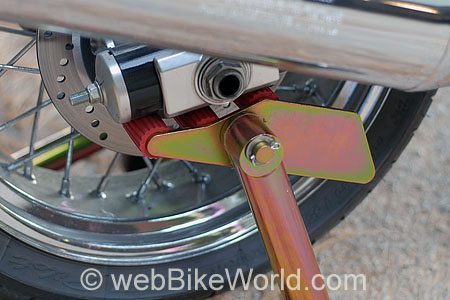
Conclusion
I have used the Pit Bull stand to adjust the chain and change the oil on the GT1000 (articles coming soon) and it works great.
The GT1000 feels very secure on the stand and the bike is lifted high enough for all necessary maintenance, although I have not yet tried to remove the rear wheel.
The stand is very robust, it works well and it can be heartily recommended to Sportclassic owners.
Although I haven’t tried it, I’m confident it would work on other motorcycles with non-spool swingarms, such as the Triumph Tiger, Triumph Thunderbird Sport and others.
More webBikeWorld:
Motorcycle Lifts, Stands, Wheel Chock Reviews
Steel Horse Front Stand Review
Master Listing of All wBW Motorcycle Product Reviews
| wBW Review: Pit Bull Swingarm Stand | |
|---|---|
| Manufacturer: Pit Bull Products | List Price (2006): $133.95 + S/H |
| Colors: Zinc-plated steel. | Made In: U.S.A. |
| Review Date: October 2006 | |
Owner Comments and Feedback
See details on submitting comments.
From “D.S.” (December 2011): “For those looking for an inexpensive bike stand, the Discount Ramps “All in One Motorcycle Stand Kit (Ai1)” works well on the GT1000.
It is called a kit because it provides all the pieces necessary to quickly assemble either a rear wheel or a front wheel stand along with the generic attachments for rear spools, swing arm (GT 1000), and front forks.
The stand is sturdy when assembled and it worked flawlessly during a recent rear tire change using the swing arm attachments (see photo).
Note: Be careful not to pinch your rear brake line against the right side swing arm while lifting the rear.
I haven’t tried it on the front yet, but a quick visual looks like everything will line up perfectly. Also, the fact that it is a cinch to assemble/disassemble makes it real easy to store when not in use.
I purchased the Ai1 at a cost of $49.99 + s/h.
For an additional $29.99 you can also purchase the XArm add-on kit which gives you the components necessary to have both a front and rear stand at the same time.”
From “G.E.” (5/09): “I’ve been looking for an inexpensive stand for my Ducati GT 1000 and I finally found one at Harbor Freight for 40 bucks that is wide enough and works fine as long as you put the lifter in front of the axle.
Sure it’s made in China but it’s beefy enough. Harbor Freight has two stands….get the steel one…the aluminum one is to use with spools…. ”
Updated Information on Using the Pit Bull Swingarm Paddock Stand
July 2007 – Apparently, we’ve been using the stand incorrectly, although we’ve had no problems at all with it!
We purchased one of the very first stands that was specially designed for the GT1000, and it didn’t come with instructions.
This email was sent recently by Pit Bull, along with the photo (below) illustrating correct usage of the stand on the Ducati GT1000.
I did notice that the stand in your picture was actually lifted improperly, due in large part to our not having instructions included initially. I have attached a photo of how the stand should be used on the swingarm as well as a set of instructions for your use.
Also, and this is purely for your personal knowledge, the reason we use only two wheels instead of quad wheels is that we don’t need them.
Quad wheels are historically a product of cheaper stands that have such weak tubing that they would flex or break altogether if they did not have those extra wheels on the inside to take some of the stress off of the tubing.
Our stands use stronger tubing and, as you noticed, top quality hand TIG-welding to ensure that there will be no flexing and therefore the quad wheel design would be a waste of materials for us.
Thank you for taking the time to write the article. If you should have any questions about your stand at any time, we would be glad to help.”


